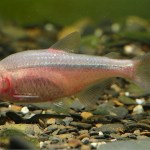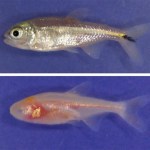Mexican
Image of eyeless Mexican tetra fish from www.seriouslyfish.com by H-J Chen.
The metabolism of most animals follows a circadian rhythm that differs between the day and night. Mexican cavefish living in constant darkness, lost this circadian rhythm some time ago. In a newly published study in PLOS ONE, researchers compared the metabolic rate of both cave- and surface-dwelling Mexican tetra fish (Astyanax mexicanus). They hypothesized that since the fish living in each location naturally experience differences in food, predation as well as exposure to daily light fluctuations, they might also…
Image from LiveScience. Credit: Richard Borowsky
Heat shock protein 90 (HSP90) helps keep proteins in the body folded properly and is thought to compensate for variations that occur in proteins over time. In a study published in Science magazine, Dr. Nicolas Rohner and colleagues showed that stress can affect the ability for HSP90 to do its job thereby unmasking these alternative versions of proteins which may lead to adaptation in some cases.
The theory was tested in fish called Mexican tetra (above), some of which adapted to life in caves leading to eventual loss of, or diminished,…

